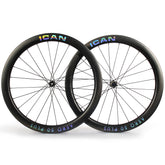How to choose a perfect road bike handlebar
The handlebars are a crucial component of your road bike as they are responsible for controlling the steering and handling of your bike. In addition, the handlebars play an important role in determining the frontal area and serve as an aerodynamic leading edge.
road bike handlebar models
There are two types of handlebars on road bikes: drop bars and flat bars. Drop bars are the most common.
1. Drop bar- Drop bars are a type of handlebar that creates a more aerodynamic shape with the rider's body, resulting in more efficient energy transfer and a faster ride. They also offer multiple driving positions due to the greater number of hand rest options. However, it is important to note that the position of the back can cause discomfort for less flexible riders. Stretching after getting off the bike can help ease the discomfort.
Here are the most important dimensions for the gravel handlebar:
- WIDTH is the distance from hood to hood. Some brands indicate this value on the outer edges, which would make the handlebar narrower than a handlebar of the same value measured from C to C, so check how they measure.
- REACH refers to the distance between the handlebars and the stem clamp area. A longer reach (>80mm) puts the rider in a more aggressive and aerodynamic stance in the drop position, suitable for higher speeds. On the other hand, a shorter reach (<75mm) is more comfortable and provides better control when riding off-road and on unpaved surfaces.
- DROP is the distance between the horizontal stem clamp and the lower end of the handlebar extension. A larger drop (>120mm) puts the rider in a more aerodynamic position, while a smaller drop (<120mm) is more comfortable and makes entry and exit easier. It's also important to note that many modern gravel bars have a less rounded "hook" shape to create a dominant drop grip.


Photo credit: https://road.cc/
2. Flat Handlebars - Flat handlebars provide a more upright riding position, allowing better forward visibility while reducing pressure on the back.

Flat handlebars
Integrated vs. independent handlebars and stem
Integrated handlebars are becoming increasingly popular, especially in today's high-tech bike industry. They are ideal for high-quality bikes and offer an elegant design. The cables are hidden inside the handlebars, which pass through the stem into the frame, resulting in a sleek and clean look.

Integrated Handlebar
Integrated system advantages:
- Aerodynamic - Hidden cables ensure a smooth profile.
- Lightweight - Minimal additional hardware saves grams.
- Tailored - Geometrically adjusted for a precise feel.
- Elegant Aesthetics - The clean integrated look appeals to many.
Integrated system disadvantages:
- Cost - Replacing an entire system will be expensive.
- Inflexibility - The fit cannot be changed like many independent parts.
- Difficult installation - Cable routing requires close attention.
Independent systems maintain flexibility for upgrades. Falls may only result in individual parts being damaged rather than requiring an entire new system to be replaced. Adjusting the stem length and handlebar rotation is as easy as loosening a few screws. Independent components also result in cost savings if replacement of individual parts becomes necessary over time.

Independent driver
Independent system advantages:
- Modularity - Parts can be individually replaced/upgraded over time.
- Cost Effectiveness - Replacing only damaged components saves money.
- Adaptability - Easily fine-tune stem angle, bar width and drop.
Independent system Disadvantages:
- Aesthetics - Cables and additional hardware look less clean.
- Special Fit - Adjusting the system may require some trial and error.
How to choose the handlebar width

If you're new to road cycling, it's a good idea to start with handlebars that are slightly wider than your shoulders. As you gain experience, you can choose narrower handlebars to improve your handling.
For more experienced riders or riders with a naturally slimmer grip, narrow bars can offer some advantages. If you find your wrists extending outward towards the brake hoods, consider narrower handlebars.
Handlebar width can affect your air resistance. In general, you can go faster with narrower handlebars. If you are currently using a 44cm handlebar and want to get a little more speed, consider switching to a 42cm or even 40cm handlebar.
Carbon links vs. Aluminum links
Carbon handlebars are becoming increasingly popular on high-end racing bikes. There are several reasons for this. First, carbon can be molded into any shape the manufacturer desires, making it more versatile. You can also save a lot of weight with carbon, which is always a plus for racing bike fans. Carbon also naturally dampens vibrations, making it more comfortable for the rider. And finally, they look pretty cool too!
What are aero bars and do I need them?
Aero road bikes are becoming increasingly popular, and the handlebar setup plays a big role in reducing drag.
Handlebars that improve aerodynamics often have a smaller surface area at the front and become flatter to create a larger surface area at the top.
This means they glide through the air more efficiently and are also comfortable to hold on long climbs. In addition, the aero bars are designed to allow internal cable routing. The A22 and A9 handlebars from ICAN are excellent examples of this. Both models are compatible with the A22 and A9 frames.
For more information on gravel handlebars, see the Gravel Handlebar Guide.







